Vesicles and Reservoirs of Basic Lava Flows in the Laoheishan and Huoshaoshan Volcanoes, NE China
Abstract
1. Introduction
2. Geological Setting
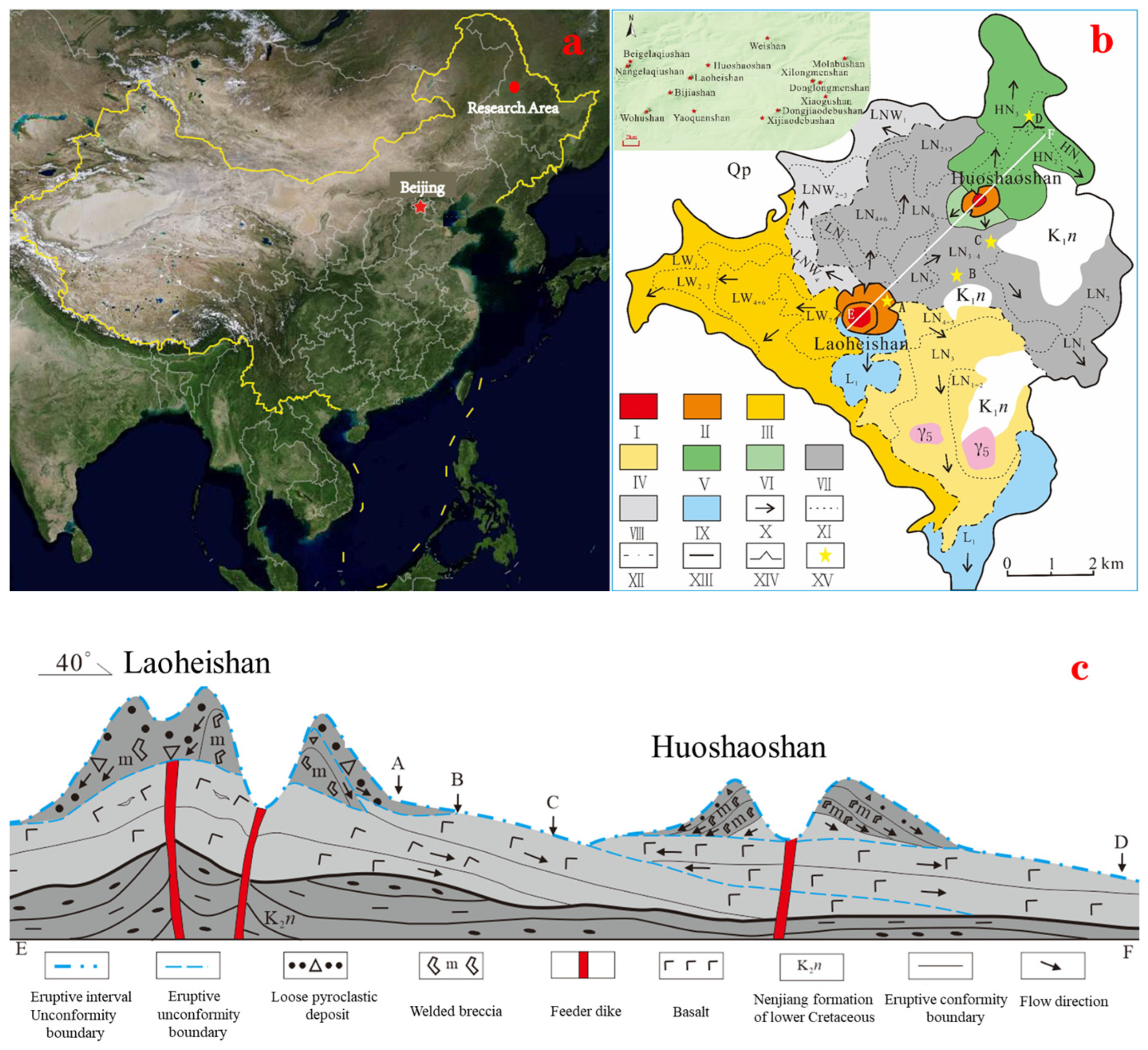
3. Materials and Methods
3.1. Study on Surface Porosity and Vesicle Characteristics
| Definition | Formula | Description |
|---|---|---|
| Elongation [31] | ε = | a is semi-long axis and b is semi-short axis. 0 represent circular objects and 1 extremely elongated ones |
| Roundness [32] | C | A is vesicle area and p is perimeter. The value range is [4π,+∞].The smaller coefficient, the closer it is to circle |
| Revised Blaschke Coefficient [33] | Cb | A is vesicle area and p is perimeter. The value range is [0, 1]. The larger coefficient, the closer it is to the circle |
| Regularity [34,35] | SF | A is vesicle area and p is perimeter. Perfect circle has SF = 1, more complex shapes have SF tending towards 0. |
3.2. Porosity and Permeability Test
4. Vesicle Distribution
4.1. Crater-Near Crater Belt
4.1.1. Vesicle Shape
4.1.2. Vesicle Arrangement
4.1.3. Vesicles Quantity
4.1.4. Surface Porosity
4.2. Proximal Belt
4.2.1. Vesicle Shape
4.2.2. Vesicle Arrangement
4.2.3. Vesicles Quantity
4.2.4. Surface Porosity
4.3. Distal Belt
4.3.1. Vesicle Shape
4.3.2. Vesicle Arrangement
4.3.3. Vesicles Quantity
4.3.4. Surface Porosity
4.3.5. Hornito
4.4. Vesicle Characteristics Based on CT Scan Images
4.5. Porosity and Permeability
4.6. Vesicle Surface Pororsity
5. Discussion
5.1. Relationship between Lava Flow Distance and Vesicles
5.2. Connectivity between Shrinkage Fractures and Vesicles
6. Conclusions
Author Contributions
Funding
Data Availability Statement
Acknowledgments
Conflicts of Interest
References
- Sruoga, P.; Rubinstein, N. Processes Controlling Porosity and Permeability in Volcanic Reservoirs from the Austral and Neuquén Basins, Argentina. AAPG Bull. 2007, 91, 115–129. [Google Scholar] [CrossRef]
- Tang, H.F.; Tian, Z.W.; Gao, Y.F.; Dai, X.J. Review of volcanic reservoir geology in China. Earth Sci. Rev. 2022, 232, 104158. [Google Scholar] [CrossRef]
- Dai, J.J.; Luo, J.L.; He, X.Y.; Ma, S.W.; Wang, C.; Xu, X.L. Oil and gas resevoir characteristics and petrogenetic evolution of the Carboniferous volcanic lava in Xiquan area, Junggar Basin. Geol. China 2020, 47, 742–754. [Google Scholar]
- Millett, J.M.; Jerram, D.A.; Planke, S. Volcanic facies architecture of early bimodal volcanism of the NW Deccan Traps: Volcanic reservoirs of the Raageshwari Deep Gas Field, Barmer Basin, India. Basin Res. 2021, 33, 3348–3377. [Google Scholar] [CrossRef]
- Wang, Z.X.; Zhao, C.L.; Liu, M.H. Volcanic lithofacies and their petrophysical properties in abei oilfeld. J. China Univ. Pet. Ed. Nat. Sci. 1991, 3, 15–21. [Google Scholar]
- Couves, C.R.; Roberts, S.; Racey, A.; Troth, I.; Best, A. Use of X-RAY computed tomography to quantify the petrophysical properties of volcanic rocks: A case study from tenerife, Canary Islands. J. Pet. Geol. 2016, 39, 79–94. [Google Scholar] [CrossRef]
- Yi, J.; Sun, F.Y.; Wang, P.J.; Shan, X.L. Vesicle distribution in acidic lava flow units in the rift basins of NE China: Implications for petroleum reservoir exploration. Geol. J. 2017, 52, 609–623. [Google Scholar] [CrossRef]
- Zhao, W.Z.; Zou, C.N.; Li, J.Z.; Feng, Z.Q.; Zhang, G.Y.; Hu, S.Y.; Kuang, L.C.; Zhang, Y. Comparative study on volcanic hydrocarbon accumulations in western and eastern China and its significance. Pet. Explor. Dev. 2009, 36, 1–11. [Google Scholar]
- Huang, Y.L.; Wang, P.J.; Shu, P.; Zhang, Y.L. Characteristics and formation mechanism of the Cretaceous intermediateand mafic volcanic reservoirs in Songliao Basin, NE China. Acta Pet. Sin. 2010, 26, 82–92. [Google Scholar]
- Xu, H.; Yulong, H.; Xingzhou, L.; Qiang, G. Logging response of vesicle zonation and reservoir significance of Paleogene basalts in Liaohe depression. World Geol. 2022, 41, 559–567. [Google Scholar]
- Aubele, J.C.; Crumpler, L.S.; Elston, W.E. Vesicle zonation and vertical structure of basalt flows. J. Volcanol. Geotherm. Res. 1988, 35, 349–374. [Google Scholar] [CrossRef]
- Sahagian, D.; Proussevitch, A.; Carlson, W. Analysis of vesicular basalts and lava emplacement processes for application as a paleobarometer/paleoaltimeter: A reply. J Geol. 2003, 111, 502–504. [Google Scholar] [CrossRef][Green Version]
- Yi, J.; Wang, P.J.; Gao, Y.F.; Yao, R.S.; Zhao, R.L.; Chen, C.Y. Vesicle distribution in basalt lava flow units in the Mesozoic rift basins of northeast China and its application in gas reservoir prediction. Can. J. Earth Sci. 2016, 53, 59–70. [Google Scholar] [CrossRef]
- Rust, A.C.; Manga, M.; Cashman, K.V. Determining flow type, shear rate and shear stress in magmas from bubble shapes and orientations. J. Volcanol. Geotherm. Res. 2003, 122, 111–132. [Google Scholar] [CrossRef]
- Shea, T.; Houghton, B.F.; Gurioli, L.; Cashman, K.V.; Hammer, J.E.; Hobden, B.J. Textural studies of vesicles in volcanic rocks: An integrated methodology. J. Volcanol. Geotherm. Res. 2009, 190, 271–289. [Google Scholar] [CrossRef]
- Farquharson, J.I.; Heap, M.J.; Varley, N.R.; Baud, P.; Reuschlé, T. Permeability and porosity relationships of edifice-forming andesites: A combined field and laboratory study. J. Volcanol. Geotherm. Res. 2015, 297, 52–68. [Google Scholar] [CrossRef]
- Peng, N.; Zhu, X.Y.; Liu, Y.S.; Nie, B.F.; Li, S. Complexity and dynamics of vesicle shapes of pumices formed in the three Tianchi volcano eruptions. Earth Sci. Front. 2019, 26, 271–280. [Google Scholar]
- Zhang, Y.Z.; Wang, D.Y.; He, S.L. Control Factors of the Volcanic Reservoir in South Xingcheng Area, Daqing. Geoscience 2009, 23, 724–730. [Google Scholar]
- Zheng, M.; Li, J.Z.; Wang, L.W.; Zhang, Q.C.; Wu, X.Z.; Yan, W.P.; Wang, Y. Reservoir space characteristics andevolution of the volcanic rocks in Yingcheng Formation of Changling fault depression, Songliao Basin. Acta Pet. Sin. 2010, 26, 135–141. [Google Scholar]
- Nan, Y.; Liu, Y.Q.; Zhou, D.W.; Zhou, N.C.; Jiao, X.; Zhou, P. Characteristics and origin of amygdale and crack fillers involcanic rock of Late Carboniferous in Santanghu basin, Xinjiang. Acla Pet. Sin. 2016, 32, 1901–1913. [Google Scholar]
- Xie, Q.B.; Han, D.X.; Zhu, X.M.; Zhu, Y.X. Reservoir space feature and evolution of the volcanic rocks in the Santanghu basin. Petrol. Explor. Dev. 2002, 29, 84–86+111. [Google Scholar]
- Shina, H.; Lindquistb, W.B.; Sahagianc, D.L.; Songd, S.R. Analysis of the vesicular structure of basalts. Comput. Geosci. 2005, 31, 473–487. [Google Scholar] [CrossRef]
- Bing, B. The Discussion of Volcanic Reservoir Characteristics and Formation Mechanism in the Southern Songliao Basin, NE China; Jilin University: Changchun, China, 2013. [Google Scholar]
- Tang, H.F.; Zhao, P.J.; Gao, Y.F.; Wang, P.J.; Qi, Y.N. Spatio-Temporal Attributes of Volcano Stratigraphy and lts Lithostratigraphic Units in a Basin. J. Jilin Univ. Earth Sci. Ed. 2017, 47, 949–973. [Google Scholar]
- Bai, Z.D.; Sun, S.P.; Li, J.Z. Cone Structure and Eruption Process of Modern Volcanoesin the Wudalianchi Area, Heilongjiang Province. Geol. Rev. 1999, 45, 369–377. [Google Scholar]
- Chen, H.Z.; Yang, J.S.; Wang, L.M.; Li, T.X.; Ou Yang, Z.G.; Zhang, L.C. Volcanic eruption fetures of Laoheishan and Huoshaoshan in Wudalianchi. World Geol. 2009, 28, 291–296. [Google Scholar]
- Xia, L.Q. On the evolution of volcanic magma from Wudalianchi, China. Acta Petrol. Sin. 1990, 1, 13–29+97. [Google Scholar]
- Liu, X. The Study on Fallout Tephra Deposits in the Laoheishan Volcano. Acta Sediment. Sin. 1997, 15, 72–77. [Google Scholar]
- Zeng, P.S.; Qiu, S.F.; Li, R.Z.; Liu, S.W.; Wang, S.A.; Zhao, J.J. Sequences Division of Quaternary Volcanic Rocks in Wudalianchi and Its Tectonic and Ecological Significances. Acta Geosci. Sin. 2021, 42, 785–802. [Google Scholar]
- Tang, H.F.; Cryton, P.; Gao, Y.F.; Huang, Y.L.; Bian, W.H. Types and Characteristics of Volcanostratigraphic Boundaries and Their Oil-Gas Reservoir Significance. Acta Geol. Sin. 2015, 89, 163–174. [Google Scholar]
- Mongrain, J.; Larsen, J.F.; King, P.L. Rapid water exsolution, degassing, and bubble collapse observed experimentally in K-phonolite melts. J. Volcanol. Geotherm. Res. 2008, 173, 178–184. [Google Scholar] [CrossRef]
- Yang, J. Analysis of shape factor of rockfill material. Yangtze River 2015, 46, 65–68. [Google Scholar]
- Tu, X.B.; Wang, S.J. Particle shape descriptor in digital image analysis. J. Geotech. Eng. 2004, 26, 659–662. [Google Scholar]
- Orsi, G.; Gallo, G.; Heiken, G.; Wohletz, K.; Yu, E.; Bonani, G. A comprehensive study of pumice formation and dispersal: The Cretaio Tephra of Ischia (Italy). J. Volcanol. Geotherm. Res. 1992, 53, 329–354. [Google Scholar] [CrossRef]
- Cashman, V.K.; Mangan, T.M. Physical aspects of magmatic degassing; II, Constraints on vesiculation processes from textural studies of eruptive products. GeoScienceWorld 1994, 30, 447–478. [Google Scholar]
- Zhang, L.H.; Pan, B.Z.; Shan, G.Y. Experimental study on rock porosity permeability under overlying conditions. Petrophys. Unconv. Oil Gas Explor. Devel. Proc. 2014, 35–38. [Google Scholar]
- Ren, J.Z. Flowing charactrristic of volcanic lava flow in Wudaliangchi volcanic group and dynamic process forming them. J. Dis. Prev. Reduct. 1995, 282, 46–53. [Google Scholar]
- Gao, W.Y.; Li, J.H.; Mao, X.; Zhang, T.R. Discussion on genetic mechanism of hornits in Wudalianchi volcanic field. Acta Pet. Sin. 2010, 26, 309–317. [Google Scholar]
- Burnham, C.W.; Jahns, R.H. A method for determining the solubility of water in silicate melts. Am. J. Sci. 1962, 260, 721–745. [Google Scholar] [CrossRef]
- Wallace, P.J.; Anderson, A.T.; Davis, A.M. Gradients in H2O, CO2, and exsolved gas in a large-volume silicic magma system: Interpreting the record preserved in melt inclusions from the Bishop Tuff. J. Geophys. Res. 1999, 104, 20097–20122. [Google Scholar] [CrossRef]
- Wang, P.J.; Feng, Z.Q. Volcanic Rocks in Petroliferous Basins; Science Press: Beijing, China, 2008. [Google Scholar]
- Liu, G.P.; Zeng, L.B.; Lei, M.S.; Zu, K.W.; Wang, F.; Liu, Q.; Li, W.F. Fracture development characteristics and main controlling factors of the volcanic reservoir in Xujiaweizi fault depression. Geol. China 2016, 43, 329–337. [Google Scholar]
- Zhou, X.; Shu, P.; Yu, S.Q.; Yu, X. Reservoir characteristics and integrated evaluation of volcanic rock in member 1, Yingcheng Formation, Xushen 9 block, Songliao Basin. Nat. Gas Geosci. 2018, 29, 62–72. [Google Scholar]
- Kattenhorn, S.A.; Schaefer, C.J. Thermal-Mechanical Modeling of Cooling History and Fracture Development in Inflationary Basalt Lava Flows. J. Volcanol. Geotherm. Res. 2008, 170, 181–197. [Google Scholar] [CrossRef]
- Qin, H.P. Characteristics of Tension Fissures and Their Genetic Analyses on the Western Lava Flows of Laoheishan Volcano, Wudalianchi; Capital Normal University: Beijing, China, 2009. [Google Scholar]
- Mao, X.; Li, J.H.; Gao, W.Y.; Zhang, T.R. Vent Distribution of Wudalianchi Volcanoes Heilongjiang Province, China, and Its Relation to Faults. Geol. J. China Univ. 2010, 16, 226–235. [Google Scholar]
- Guo, T.C.; Tang, H.F.; Wang, H.F. Reservoir distribution pattern of the hypabyssal intrusive rocks: A case study from the Miocene hypabyssal dykes of Lyttelton volcano, New Zealand. Acta Geol. Sin. 2021, 95, 3885–3898. [Google Scholar]
- Ma, Z.J.; Zhang, Z.J.; Zhan, T.; Yang, Y.; Xu, J.M.; Li, L.H.; Li, E. Formation of surface crack of hornito at Wudalianchi volcano, Heilongjiang Province, China. J. Eng. Geol. 2019, 27, 294–301. [Google Scholar]
- Lawn, B. Fracture of Brittle Solids; Cambridge University Press: London, UK, 1975. [Google Scholar]
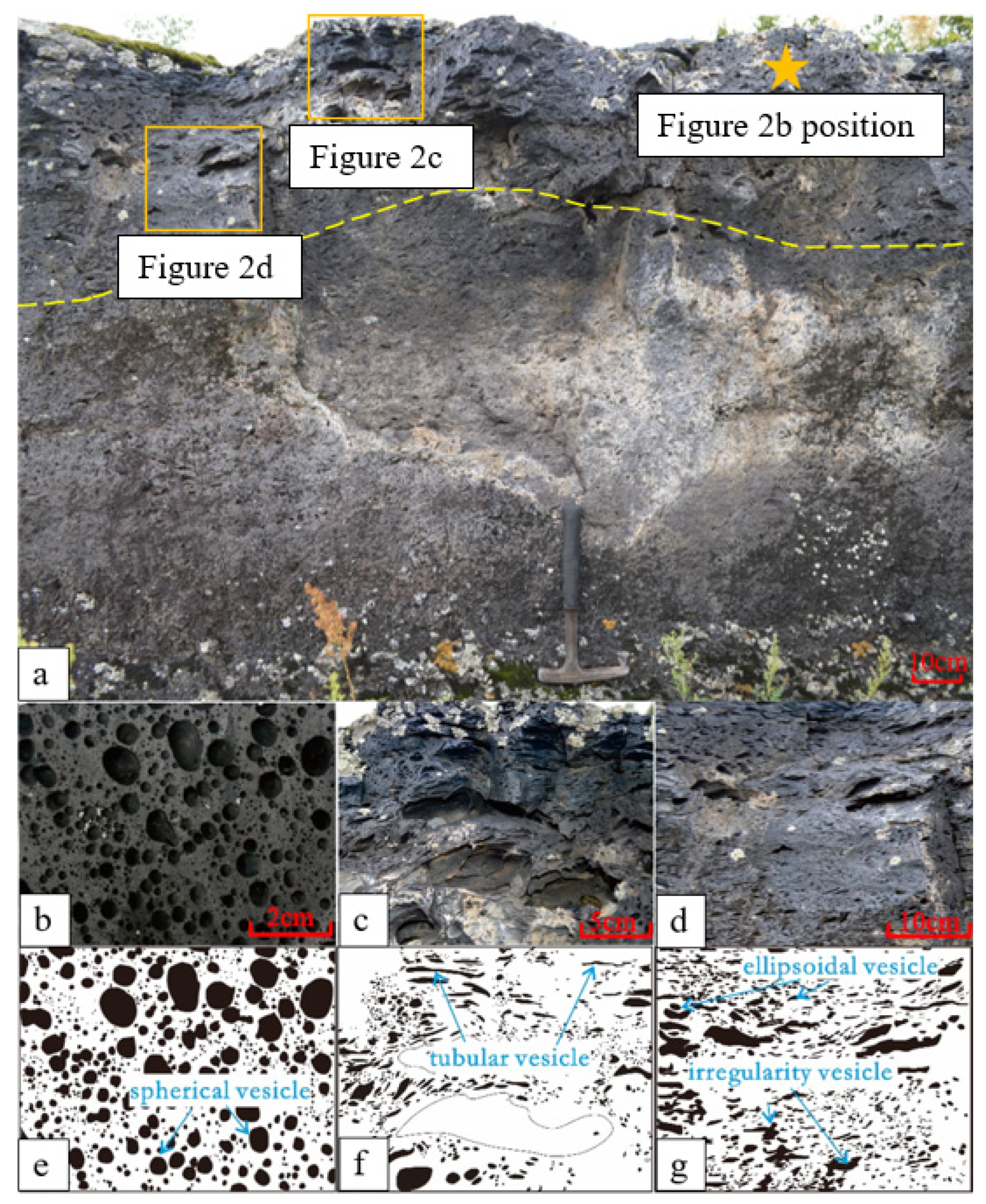
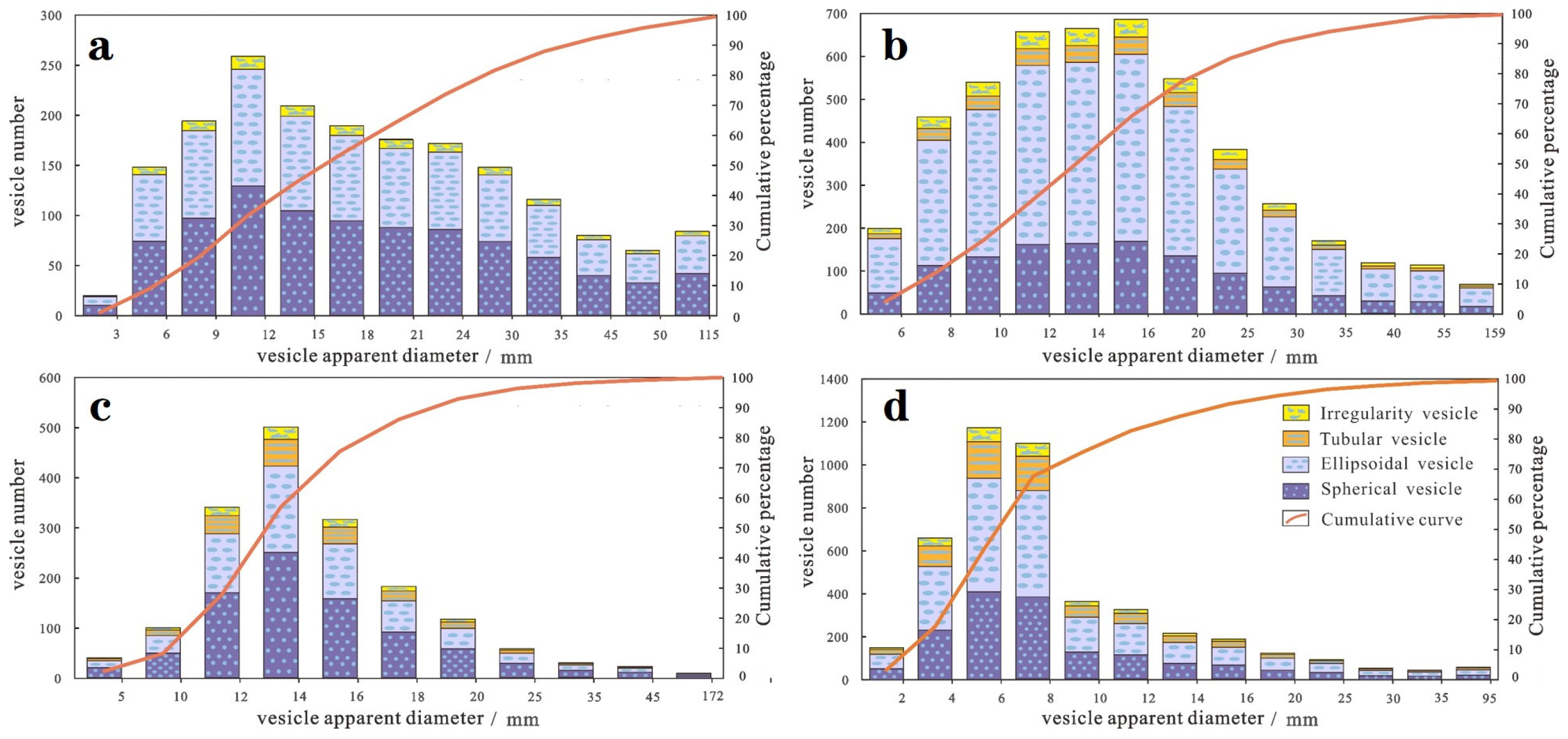
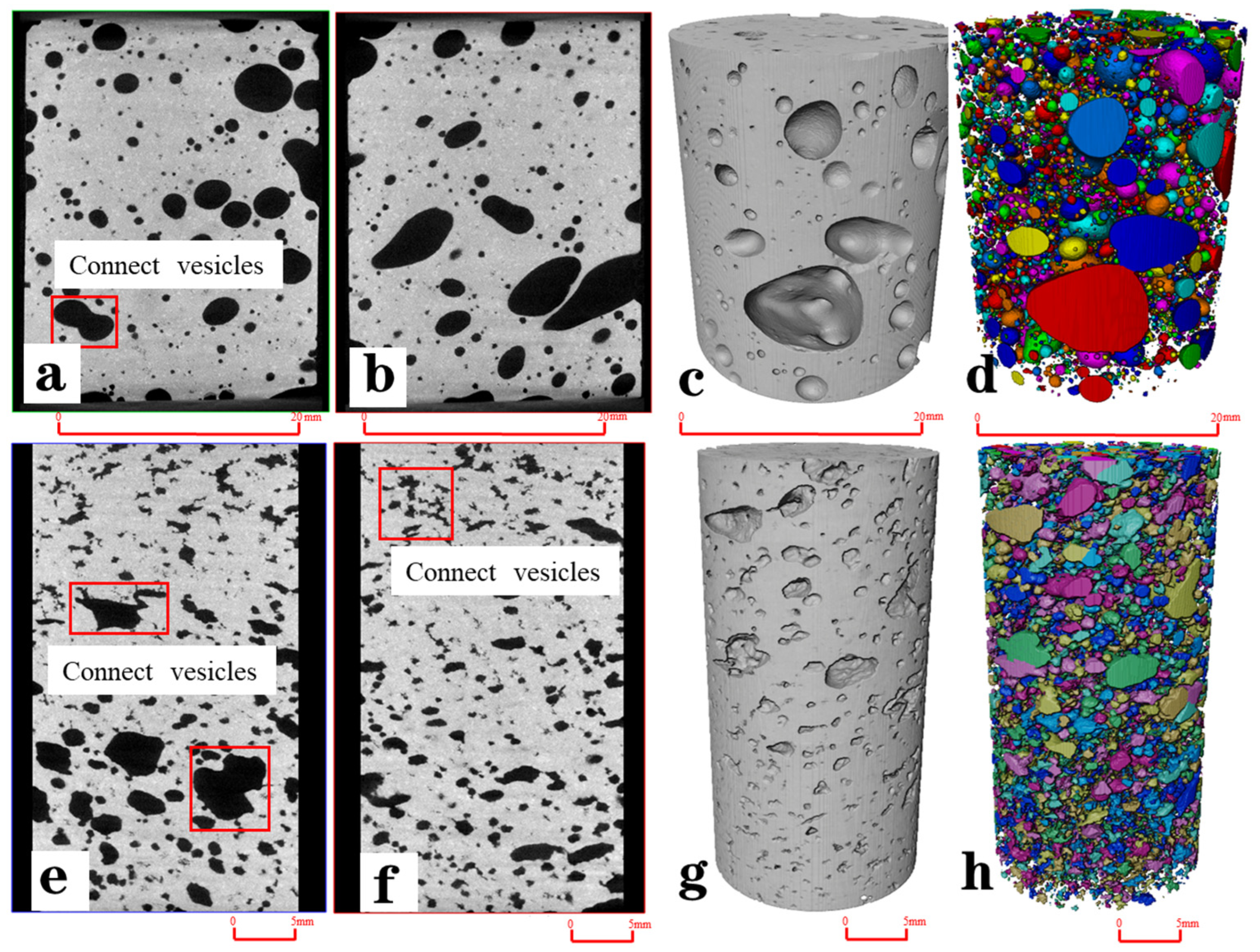

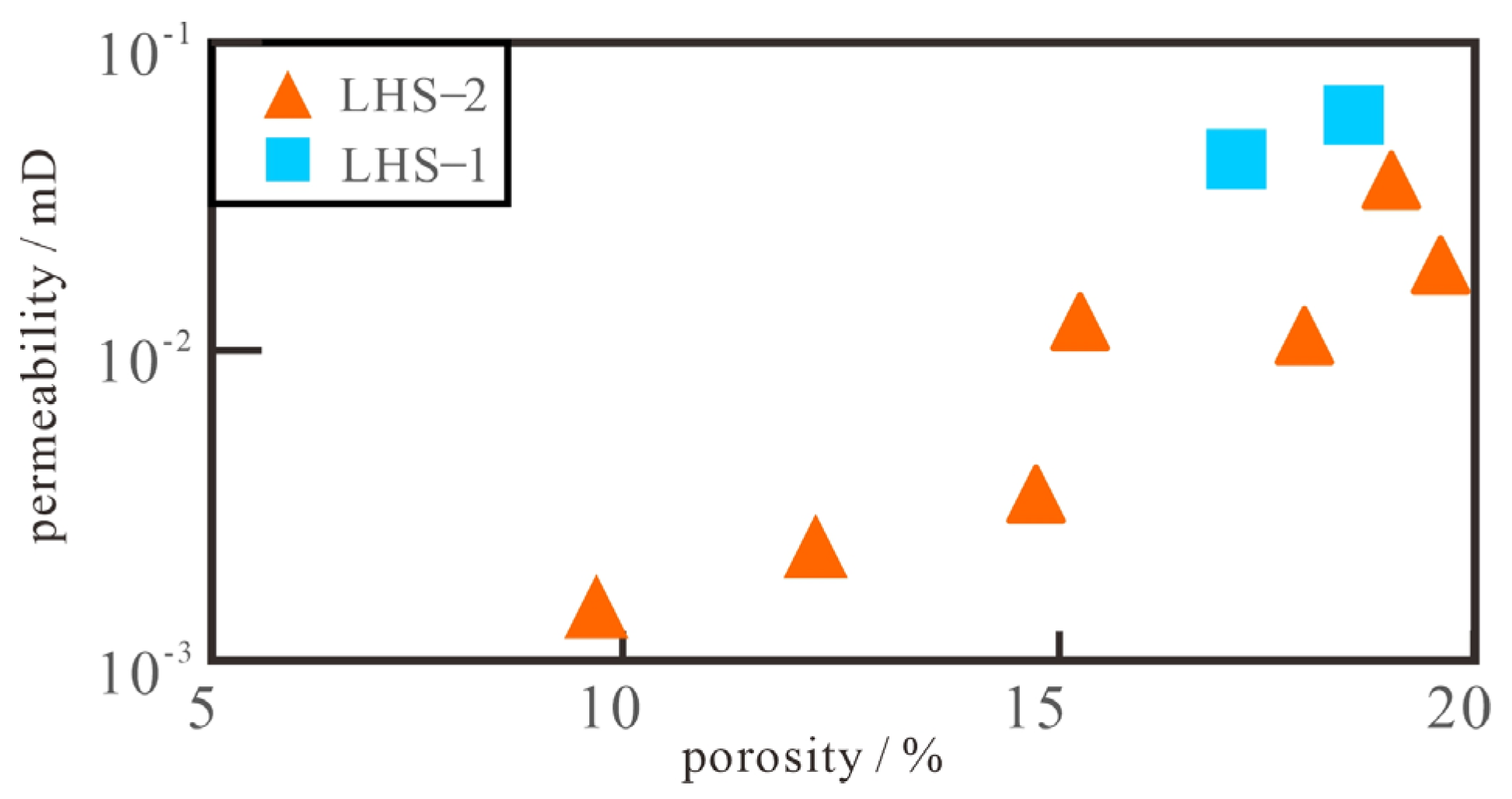
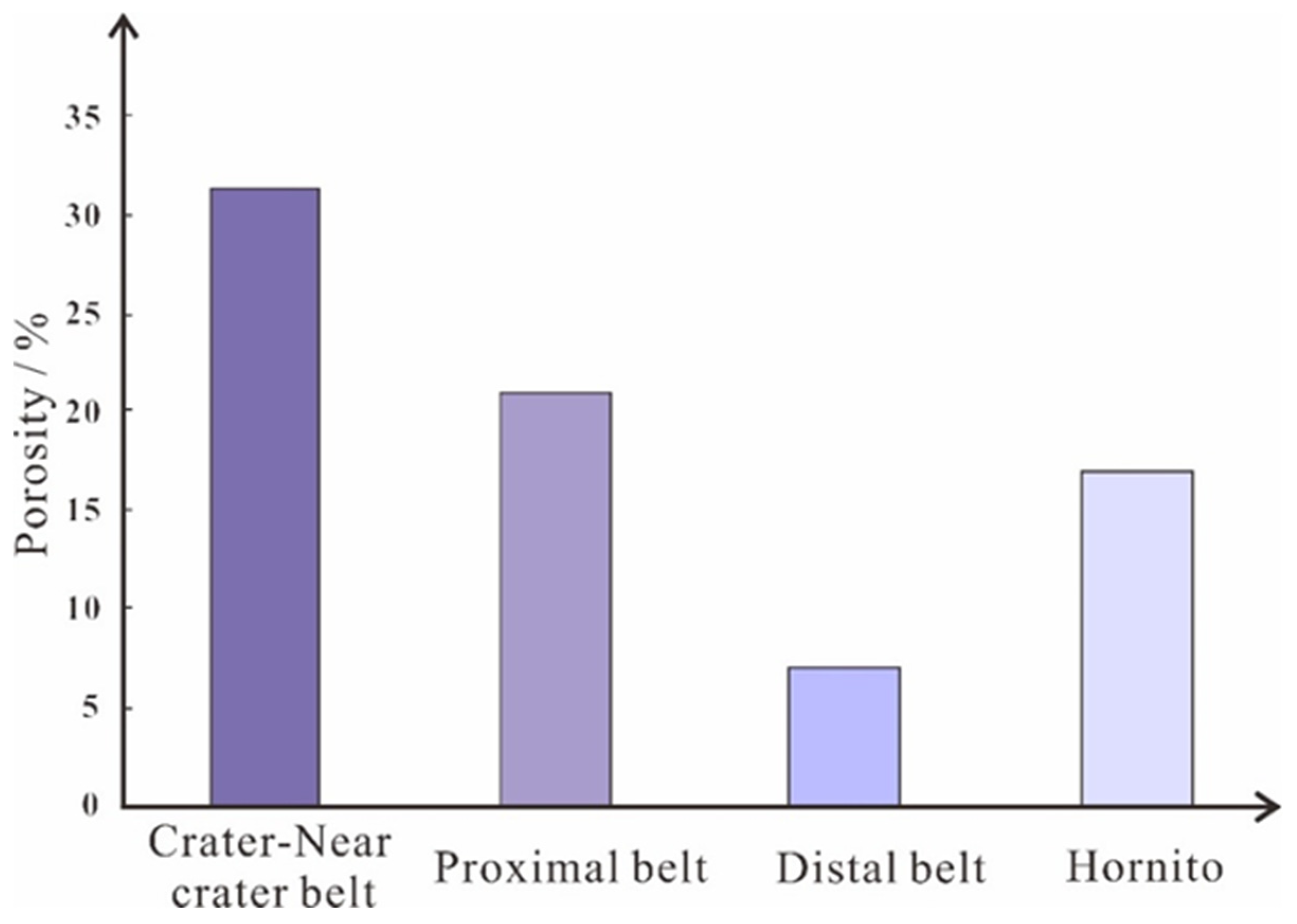
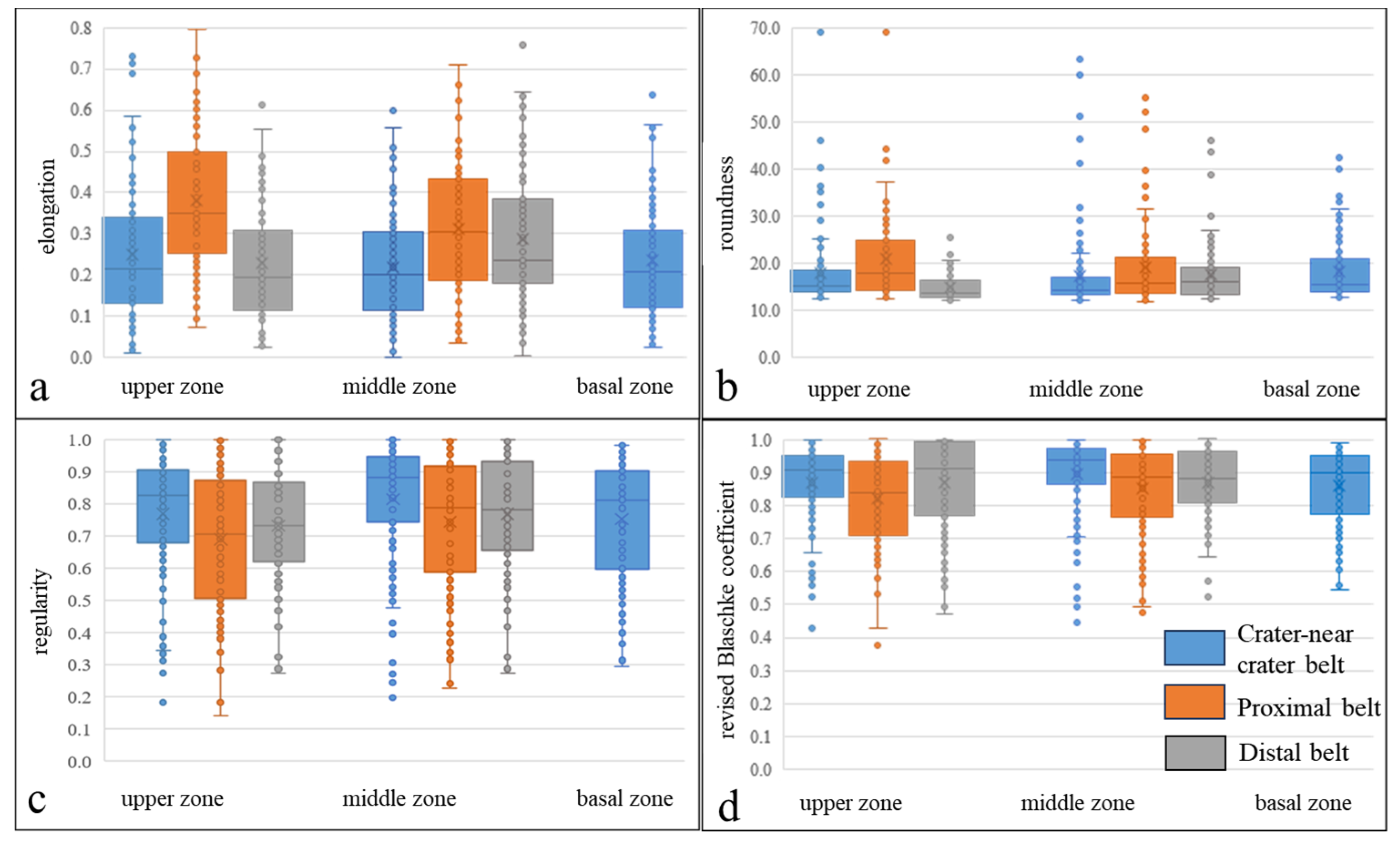

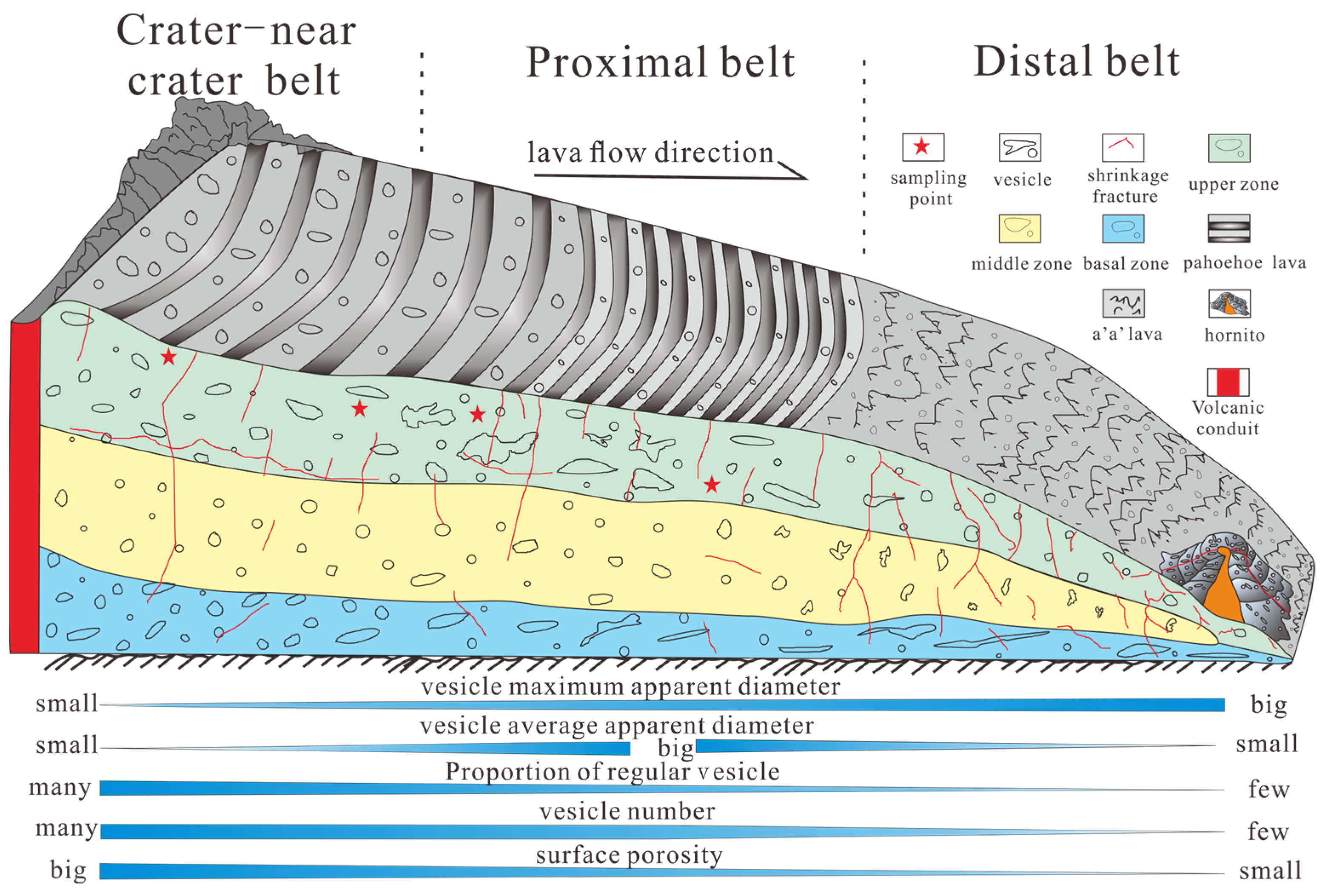

Disclaimer/Publisher’s Note: The statements, opinions and data contained in all publications are solely those of the individual author(s) and contributor(s) and not of MDPI and/or the editor(s). MDPI and/or the editor(s) disclaim responsibility for any injury to people or property resulting from any ideas, methods, instructions or products referred to in the content. |
© 2023 by the authors. Licensee MDPI, Basel, Switzerland. This article is an open access article distributed under the terms and conditions of the Creative Commons Attribution (CC BY) license (https://creativecommons.org/licenses/by/4.0/).
Share and Cite
Lu, G.; Tang, H.; Wang, Q.; Yang, L.; Hu, J.; Wu, H.; Bai, J.; Tian, Z. Vesicles and Reservoirs of Basic Lava Flows in the Laoheishan and Huoshaoshan Volcanoes, NE China. Minerals 2023, 13, 1434. https://doi.org/10.3390/min13111434
Lu G, Tang H, Wang Q, Yang L, Hu J, Wu H, Bai J, Tian Z. Vesicles and Reservoirs of Basic Lava Flows in the Laoheishan and Huoshaoshan Volcanoes, NE China. Minerals. 2023; 13(11):1434. https://doi.org/10.3390/min13111434
Chicago/Turabian StyleLu, Guochao, Huafeng Tang, Qingbin Wang, Liying Yang, Jingsong Hu, Haichao Wu, Jiawei Bai, and Zhiwen Tian. 2023. "Vesicles and Reservoirs of Basic Lava Flows in the Laoheishan and Huoshaoshan Volcanoes, NE China" Minerals 13, no. 11: 1434. https://doi.org/10.3390/min13111434
APA StyleLu, G., Tang, H., Wang, Q., Yang, L., Hu, J., Wu, H., Bai, J., & Tian, Z. (2023). Vesicles and Reservoirs of Basic Lava Flows in the Laoheishan and Huoshaoshan Volcanoes, NE China. Minerals, 13(11), 1434. https://doi.org/10.3390/min13111434







